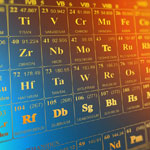National Periodic Table Day Date in the current year: February 7, 2026
 On February 7, chemistry nerds across the nation celebrate National Periodic Table Day. This amazing holiday was created to recognize the importance of the periodic table of elements and celebrate all scientists who have contributed to its invention and development.
On February 7, chemistry nerds across the nation celebrate National Periodic Table Day. This amazing holiday was created to recognize the importance of the periodic table of elements and celebrate all scientists who have contributed to its invention and development.The periodic table of the chemical elements, commonly referred to as simply the periodic table, is a graphic representation of the periodic law, which states that the properties of chemical elements (atomic radius, electronegativity, electron affinity, ionization energy, metallic character and valence) exhibit an approximate periodic dependence on their atomic numbers.
The periodic law was formulated by Russian chemist Dmitri Mendeleev, who is credited with developing the first generally accepted periodic table. However, there were earlier attempts to classify chemical elements, and Mendeleev wasn’t the first chemist to notice the periodicity among them.
The first attempts to classify the known elements were made by German chemist Johann Wolfgang Döbereiner and a number of other scientists in the early 19th century, who successfully identified relationships between the elements in small groups, but failed to create a system that would encompass all known chemical elements.
English chemist John Newlands was the first to devise a periodic table where chemical elements were arranged according to their relative atomic masses. It was published in Chemical News on February 7, 1863. Although not without its flaws, Newlands’s table is considered the first successful periodic table.
Another early version of the periodic table was created by German chemist Lotner Meyer, who published it in 1864. But it is Russian chemist Dmitri Mendeleev who is credited with developing the periodic system that had the most impact on the scientific community. He published the first version of his periodic table in 1869 and wrote an article describing predictions for yet unknown chemical elements based on his table in 1871.
The periodic table is regarded as one of the fundamental discoveries in chemistry and physics. Of course, the importance of Mendeleev’s contribution is indisputable, but it is also important to recognize the groundwork of other scientists. This is why National Periodic Table Day was inspired by the work of John Newlands.
National Periodic Table Day was founded by David T. Steineker, an author, inventor, and public school chemistry teacher from Kentucky. He chose to celebrate the holiday on February 7 to celebrate John Newlands’s contribution, which is often overlooked. Coincidentally, Dmitri Mendeleev was born on February 8, which is a great excuse to extend the celebration an extra day.
But how exactly does one celebrate National Periodic Table Day? There are plenty of ways to pay tribute to this iconic invention. You can learn interesting facts about the periodic table and various chemical elements and share them with anyone who is willing to listen, play a chemistry trivia challenge with your friends and family, sign up for an online chemistry course to brush up your knowledge, donate to or volunteer at your local STEM program for underprivileged children, and spread the word about the holiday on social media with the hashtags #NationalPeriodicTableDay and #PeriodicTableDay.
- Category
- Unofficial Holidays
- Country
- USA
- Tags
- National Periodic Table Day, unofficial observances, observances in the US, periodic table, John Newlands